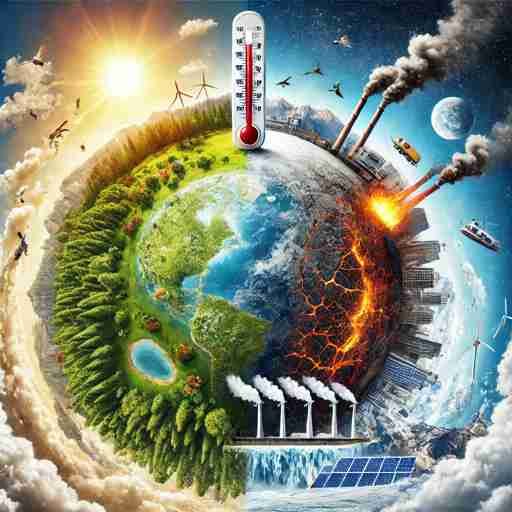Introduction
Climate change is one of the biggest challenges facing our planet today. But what exactly is climate change, and how does it affect us? In simple terms, climate change refers to long-term shifts in temperatures and weather patterns. While some of these changes occur naturally, human activities have significantly increased the rate of climate change.
This article explains the science behind climate change in an easy-to-understand way. You will also learn key facts, causes, effects, and solutions to climate change.
What is Climate Change?
Climate change refers to significant changes in global temperatures and weather patterns over time. It happens due to both natural causes and human activities. The Earth’s climate has changed many times over millions of years, but today’s climate change is happening much faster because of human actions.
Causes of Climate Change
1. Greenhouse Gas Emissions
One of the biggest causes of climate change is the increase in greenhouse gases (GHGs) like carbon dioxide (CO2), methane (CH4), and nitrous oxide (N2O). These gases trap heat in the atmosphere and lead to global warming.
2. Burning Fossil Fuels
Coal, oil, and natural gas are fossil fuels. When burned, they release large amounts of carbon dioxide, which contributes to climate change. Power plants, vehicles, and industries are major sources of fossil fuel emissions.
3. Deforestation
Trees absorb carbon dioxide and help regulate the Earth’s temperature. When forests are cut down, less CO2 is absorbed, and more remains in the atmosphere, leading to higher temperatures.
4. Agriculture and Livestock
Farming releases methane from livestock and nitrous oxide from fertilizers. Both of these gases contribute to climate change.
5. Industrial Activities
Industries release large amounts of pollutants and greenhouse gases into the air. Manufacturing, mining, and other industrial activities are major contributors to global warming.
Effects of Climate Change
1. Rising Global Temperatures
The Earth’s temperature has increased by about 1.1°C (2°F) since the late 19th century. If greenhouse gas emissions continue, temperatures will keep rising, causing extreme heatwaves.
2. Melting Ice Caps and Rising Sea Levels
Polar ice caps and glaciers are melting, leading to rising sea levels. This puts coastal cities at risk of flooding.
3. Extreme Weather Events
Climate change causes more frequent hurricanes, wildfires, floods, and droughts. These disasters can lead to loss of lives and destruction of property.
4. Ocean Acidification
Oceans absorb CO2, making them more acidic. This harms marine life, including coral reefs and fish populations.
5. Impact on Agriculture
Unpredictable weather patterns, droughts, and floods affect crop production. This can lead to food shortages and higher prices.
6. Threats to Wildlife
Many species struggle to adapt to changing temperatures and habitats. Some are at risk of extinction due to habitat destruction.
Solutions to Climate Change
1. Using Renewable Energy
Switching to clean energy sources like solar, wind, and hydropower reduces dependence on fossil fuels.
2. Energy Efficiency
Using energy-efficient appliances, LED bulbs, and insulation helps reduce energy consumption and lower emissions.
3. Reforestation
Planting more trees helps absorb carbon dioxide and cool the planet.
4. Sustainable Transportation
Using public transport, cycling, walking, and electric vehicles reduces carbon emissions.
5. Reducing Waste
Minimizing waste and recycling materials lowers carbon emissions from landfills.
6. Government Policies
Strong environmental policies, carbon taxes, and international agreements can help combat climate change on a larger scale.
10 FAQs About Climate Change
1. What are the main causes of climate change?
Climate change is caused by greenhouse gas emissions from burning fossil fuels, deforestation, agriculture, and industrial activities.
2. How does climate change affect the environment?
Climate change leads to rising temperatures, melting ice caps, extreme weather, sea-level rise, and loss of biodiversity.
3. What are the solutions to climate change?
Solutions include using renewable energy, energy efficiency, reforestation, sustainable transportation, and reducing waste.
4. How does climate change affect human health?
It increases the risk of heatstroke, respiratory diseases, malnutrition, and the spread of infectious diseases.
5. What role do greenhouse gases play in climate change?
Greenhouse gases trap heat in the atmosphere, causing global warming and climate change.
6. Why is climate change happening so fast?
Human activities like burning fossil fuels and deforestation have accelerated climate change beyond natural variations.
7. What are the effects of climate change on agriculture?
Climate change affects crop yields, disrupts farming seasons, and increases the risk of droughts and floods.
8. Can individual actions help fight climate change?
Yes, reducing energy use, eating less meat, using public transport, and planting trees can make a difference.
9. What countries are most affected by climate change?
Low-lying coastal nations, island countries, and developing nations are most vulnerable to rising sea levels and extreme weather.
10. What happens if we do nothing about climate change?
If no action is taken, climate change will lead to severe weather events, food and water shortages, loss of biodiversity, and economic decline.
Conclusion
Climate change is a global crisis that needs urgent action. Understanding its causes, effects, and solutions can help us take the necessary steps to protect our planet. Governments, businesses, and individuals must work together to reduce emissions, use clean energy, and protect natural resources. Small changes in daily life can make a big difference in the fight against climate change.
By spreading awareness and taking action, we can ensure a sustainable future for future generations.
